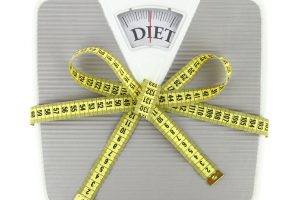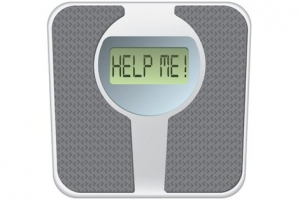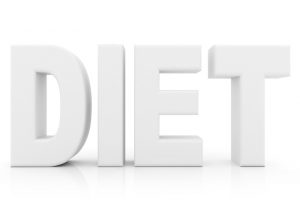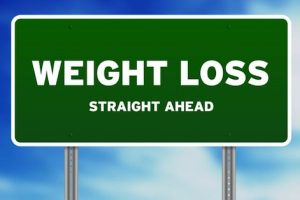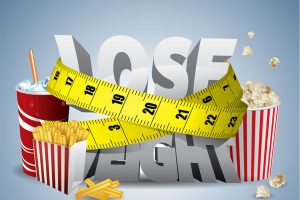Have you ever noticed with jealousy that you don’t seem to be able to eat as much as some other people? You may be one of the rare individuals blessed with the gift of eating as much as you want, but more likely you are one of the masses who have to watch what they eat to stay trim. The first step in taking good care of your body is to know how many calories you should be eating a day. So take out a calculator and sit yourself down, I’m going to explain it all. Be sure to keep track of the numbers you get for each step!
Find out your Resting Metabolic Rate (RMR)
Calculating the number of calories you need each day for normal body functioning is the first step in finding how many calories you should be eating a day if you want to lose or gain weight.
Step 1: Weight
Did you know that heavier people often have more muscle mass than the general population? Any extra pounds make for built-in weight training, which can put tremendous strain on the bones and cause the muscles to kick into overdrive. Those with more muscle mass, or perhaps just a larger frame, also need more calories each day. Fortunately, this is one part of your energy equation that you can change by adding muscle or losing weight.
Take your weight (and I mean your accurate current weight) and follow the equation below:
FOR KILOGRAMS: 10 times your weight in kilos
FOR POUNDS: 4.54 times your weight in pounds
Step 2: Height
The influence of height on daily calories is a bit less of a mystery- taller people have inches of body to feed than shorter people do! Unlike weight this is not something that you can modify.
Find out your high in inches (12 inches to a foot) or meters and use the following equation:
FOR CENTIMETERS: 6.25 times your height in centimeters
FOR INCHES: 15.88 times your height in inches
Step 3: Age
Age has a negative effect on daily calories and it shouldn’t come as a surprise. Yes, you tend to be less active as you get older, but also your body doesn’t function as effectively, your cells don’t replicate as frequently, and you have a general lower need for nutrients. This equation only works if you use your true age, not how old you tell your friends are. If you don’t know your age, consult a calendar.
AGE: 5 times your age in years
Step 4: Gender
I hate to say that men need more calories than women- even women of the same age, height, and weight. This step is where you can add everything up: add your numbers from steps 1 and 2, subtract the number from step 3, and add or subtract the number below according to your gender.
MEN: Add 5
WOMEN: Subtract 161
Step 5: Activity
The number you got in the previous step is called your resting metabolic rate (RMR). This is the amount of calories you burn each day without trying. These calories go toward maintaining your brain, heart, liver, kidneys, and muscles. If you want to understand how your daily activities factor into this equation, you need to do some soul searching and think about just how active you are in your day. Your ‘activity factor’ usually falls somewhere between 1.2 and 1.9 with 1.2 being somebody who is completely sedentary with no daily exercise and 1.9 being a professional or endurance athlete. Choose where you fall with care- if you overestimate you are only cheating yourself!
SEDENTARY: Multiply RMR by 1.2
MODERATE EXERCISE: Multiply RMR by 1.4
INTENSE EXERCISE: Multiply RMR by 1.75
ENDURANCE EXERCISE: Multiply RMR by 1.9
How many calories to eat per day if you want to lose weight?
You may or may not choose to modify this number, depending on whether you want to lose, gain, or maintain your weight. If you want to keep your weight the same but transition fat to muscle there is no need to change your daily calorie intake.
TO GAIN WEIGHT: Add 300-500 calories
TO MAINTAIN WEIGHT: Add 0 calories
TO LOSE WEIGHT:Subtract 300-500 calories
Take the number you get and try to keep your calories to about that level each day! This method is not foolproof; using an equation to determine your total daily calories is fine for estimation, but it doesn’t account for your body’s innate metabolism. The simplified version of this equation (called the Mifflin St. Jeor equation) is below:
MALE: 10 * weigh (in kg) + 6.25 * height (in cm) – 5 * age + 5
FEMALE: 10 * weigh (in kg) + 6.25 * height (in cm) – 5 * age – 161
For example:
For a male age 35, weight 90kg, height 1.80m doing little or no exercise the Resting Metabolic Rate is 1855 calories and the number of calories needed per day to maintain current weight is 2226 calories. Our calculator also shows the BMI which is 27.7 (according to BMI classification the person belongs in the overweight category). In other words if this person wants to lose weight he needs to reduce calories per day to a number below 2226. Let’s say that he manages to consume 2000 calories per day then he will save 6000 calories per month which is about 2 pounds (1 pound = 3500 calories).
How to estimate your daily calorie requirements
Finally, here are some tips for better estimating your daily calories:
- Get an accurate and current weight
- Be honest with yourself about your daily exercise habits
- Don’t try to decrease your calories more by more than 500 a day to lose weight
- Speak to a qualified health professional about getting a body composition analysis
- Speak with a qualified fitness professional about determining your resting metabolic rate (RMR) through scientific testing

